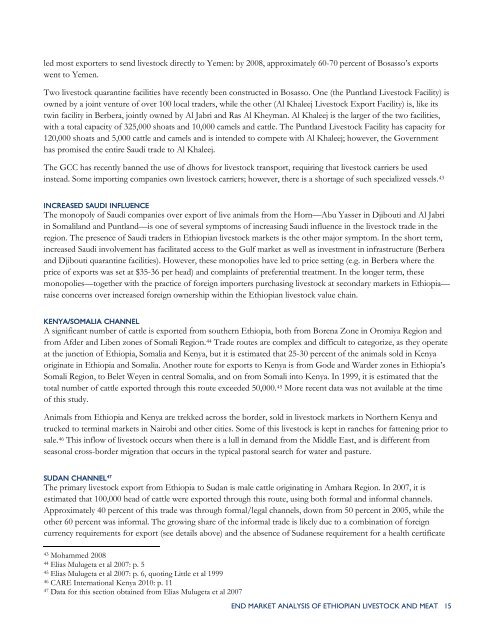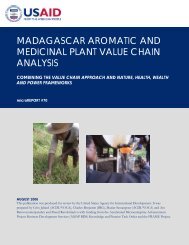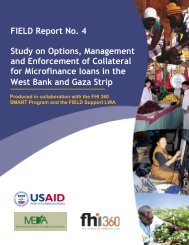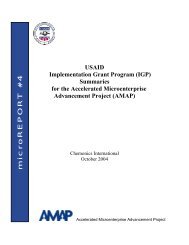End Market Analysis of Ethiopian Livestock and ... - USAID Microlinks
End Market Analysis of Ethiopian Livestock and ... - USAID Microlinks
End Market Analysis of Ethiopian Livestock and ... - USAID Microlinks
You also want an ePaper? Increase the reach of your titles
YUMPU automatically turns print PDFs into web optimized ePapers that Google loves.
led most exporters to send livestock directly to Yemen: by 2008, approximately 60-70 percent <strong>of</strong> Bosasso’s exports<br />
went to Yemen.<br />
Two livestock quarantine facilities have recently been constructed in Bosasso. One (the Puntl<strong>and</strong> <strong>Livestock</strong> Facility) is<br />
owned by a joint venture <strong>of</strong> over 100 local traders, while the other (Al Khaleej <strong>Livestock</strong> Export Facility) is, like its<br />
twin facility in Berbera, jointly owned by Al Jabri <strong>and</strong> Ras Al Kheyman. Al Khaleej is the larger <strong>of</strong> the two facilities,<br />
with a total capacity <strong>of</strong> 325,000 shoats <strong>and</strong> 10,000 camels <strong>and</strong> cattle. The Puntl<strong>and</strong> <strong>Livestock</strong> Facility has capacity for<br />
120,000 shoats <strong>and</strong> 5,000 cattle <strong>and</strong> camels <strong>and</strong> is intended to compete with Al Khaleej; however, the Government<br />
has promised the entire Saudi trade to Al Khaleej.<br />
The GCC has recently banned the use <strong>of</strong> dhows for livestock transport, requiring that livestock carriers be used<br />
instead. Some importing companies own livestock carriers; however, there is a shortage <strong>of</strong> such specialized vessels. 43<br />
INCREASED SAUDI INFLUENCE<br />
The monopoly <strong>of</strong> Saudi companies over export <strong>of</strong> live animals from the Horn—Abu Yasser in Djibouti <strong>and</strong> Al Jabri<br />
in Somalil<strong>and</strong> <strong>and</strong> Puntl<strong>and</strong>—is one <strong>of</strong> several symptoms <strong>of</strong> increasing Saudi influence in the livestock trade in the<br />
region. The presence <strong>of</strong> Saudi traders in <strong>Ethiopian</strong> livestock markets is the other major symptom. In the short term,<br />
increased Saudi involvement has facilitated access to the Gulf market as well as investment in infrastructure (Berbera<br />
<strong>and</strong> Djibouti quarantine facilities). However, these monopolies have led to price setting (e.g. in Berbera where the<br />
price <strong>of</strong> exports was set at $35-36 per head) <strong>and</strong> complaints <strong>of</strong> preferential treatment. In the longer term, these<br />
monopolies—together with the practice <strong>of</strong> foreign importers purchasing livestock at secondary markets in Ethiopia—<br />
raise concerns over increased foreign ownership within the <strong>Ethiopian</strong> livestock value chain.<br />
KENYA/SOMALIA CHANNEL<br />
A significant number <strong>of</strong> cattle is exported from southern Ethiopia, both from Borena Zone in Oromiya Region <strong>and</strong><br />
from Afder <strong>and</strong> Liben zones <strong>of</strong> Somali Region. 44 Trade routes are complex <strong>and</strong> difficult to categorize, as they operate<br />
at the junction <strong>of</strong> Ethiopia, Somalia <strong>and</strong> Kenya, but it is estimated that 25-30 percent <strong>of</strong> the animals sold in Kenya<br />
originate in Ethiopia <strong>and</strong> Somalia. Another route for exports to Kenya is from Gode <strong>and</strong> Warder zones in Ethiopia’s<br />
Somali Region, to Belet Weyen in central Somalia, <strong>and</strong> on from Somali into Kenya. In 1999, it is estimated that the<br />
total number <strong>of</strong> cattle exported through this route exceeded 50,000. 45 More recent data was not available at the time<br />
<strong>of</strong> this study.<br />
Animals from Ethiopia <strong>and</strong> Kenya are trekked across the border, sold in livestock markets in Northern Kenya <strong>and</strong><br />
trucked to terminal markets in Nairobi <strong>and</strong> other cities. Some <strong>of</strong> this livestock is kept in ranches for fattening prior to<br />
sale. 46 This inflow <strong>of</strong> livestock occurs when there is a lull in dem<strong>and</strong> from the Middle East, <strong>and</strong> is different from<br />
seasonal cross-border migration that occurs in the typical pastoral search for water <strong>and</strong> pasture.<br />
SUDAN CHANNEL<br />
47<br />
The primary livestock export from Ethiopia to Sudan is male cattle originating in Amhara Region. In 2007, it is<br />
estimated that 100,000 head <strong>of</strong> cattle were exported through this route, using both formal <strong>and</strong> informal channels.<br />
Approximately 40 percent <strong>of</strong> this trade was through formal/legal channels, down from 50 percent in 2005, while the<br />
other 60 percent was informal. The growing share <strong>of</strong> the informal trade is likely due to a combination <strong>of</strong> foreign<br />
currency requirements for export (see details above) <strong>and</strong> the absence <strong>of</strong> Sudanese requirement for a health certificate<br />
43 Mohammed 2008<br />
44 Elias Mulugeta et al 2007: p. 5<br />
45 Elias Mulugeta et al 2007: p. 6, quoting Little et al 1999<br />
46 CARE International Kenya 2010: p. 11<br />
47 Data for this section obtained from Elias Mulugeta et al 2007<br />
END MARKET ANALYSIS OF ETHIOPIAN LIVESTOCK AND MEAT 15





